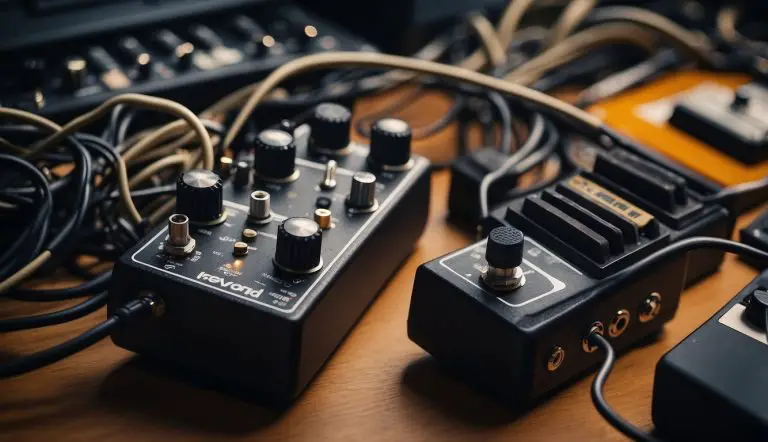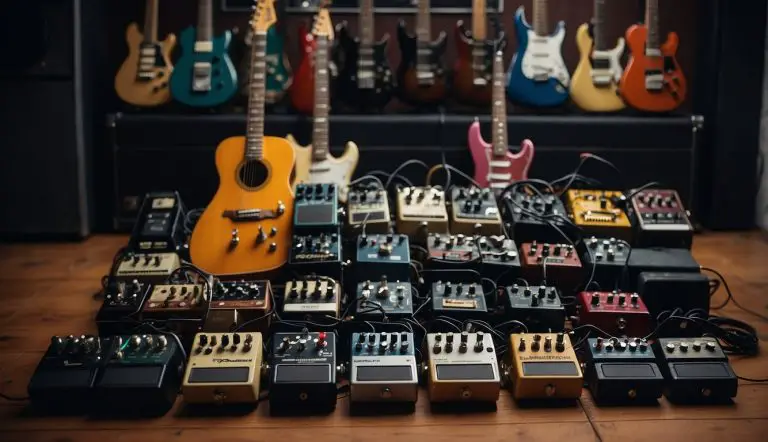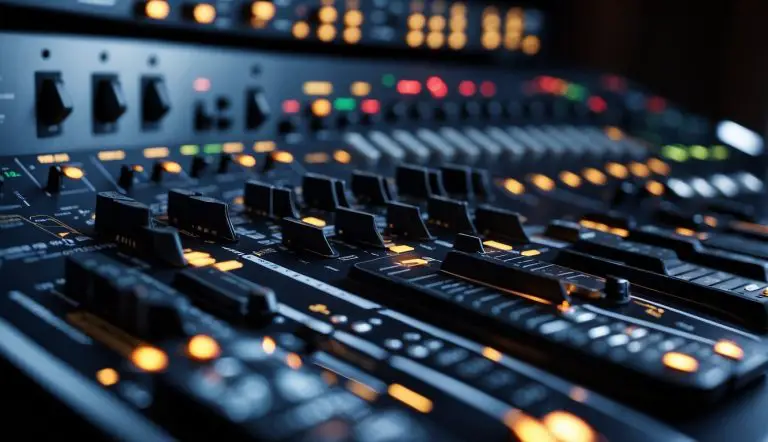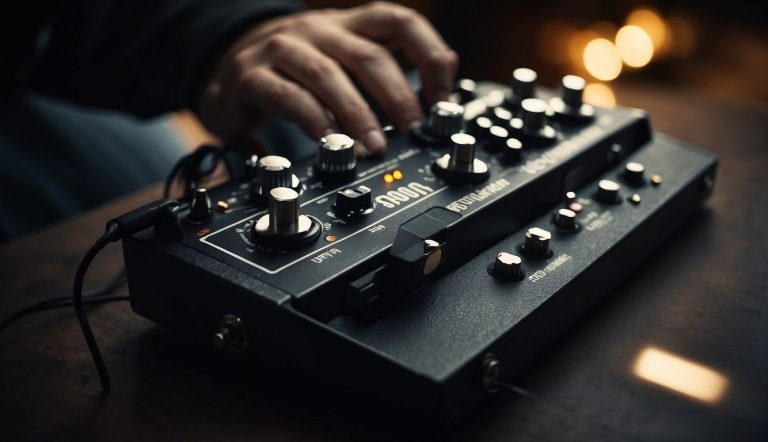Best Distortion Pedal: Top 10 Picks for Guitarists in 2023
As a musician, I know how important the right distortion pedal can be for achieving the perfect tone. Whether you’re a guitarist, bassist, or any other type of musician, a good distortion pedal can make all the difference in your sound. With so many options on the market, it can be overwhelming to choose the best one for your needs.
After doing some research and testing, I have compiled a list of the best distortion pedals available in 2023. These pedals offer a wide range of tonal options, from classic to modern, and are suitable for various genres of music. Whether you’re looking for a crunchy, vintage sound or a high-gain metal tone, there’s something on this list for you. So, without further ado, let’s dive into the top distortion pedals of 2023.
What is a Distortion Pedal?
As a guitarist, I have come across the term “distortion pedal” many times, and it’s an essential tool for many genres of music. A distortion pedal is an effects pedal that alters the guitar’s sound by adding distortion, overdrive, or fuzz. It works by increasing the gain of the signal, which causes the sound to become saturated and distorted.
Distortion pedals come in many shapes and sizes, and each one has its own unique sound. Some pedals are designed to produce a classic rock sound, while others are more versatile and can be used for a wide range of genres.
The main components of a distortion pedal are gain, volume, and tone. The gain controls how much distortion is added to the signal, while the volume controls the overall output level. The tone control adjusts the bass and treble frequencies, allowing you to shape the sound to your liking.
There are also other features that some distortion pedals may have, such as a noise gate, filter, or three-band EQ. A noise gate helps to reduce unwanted noise, while a filter can be used to shape the sound further. A three-band EQ allows you to adjust the bass, mid, and treble frequencies independently.
Distortion pedals can be used for a variety of genres, including rock, metal, and even blues. They are also versatile and can be used in various settings, from bedroom practice to live performances.
In terms of construction, distortion pedals can use different components, such as diodes or transistors, to achieve their sound. Some pedals may use stacked gain stages, which produce a tighter and more saturated sound.
Overall, a distortion pedal is an essential tool for any guitarist looking to add some grit and distortion to their sound. With so many options available, it’s important to find the right one that suits your playing style and genre preferences.
Top Distortion Pedals
As a guitarist, I know how important it is to have a reliable distortion pedal that can deliver the right amount of crunch and grit for any performance or recording session. After researching and testing various options, I have compiled a list of the top distortion pedals that every guitarist should consider.
Boss DS-1
The Boss DS-1 is a classic distortion pedal that has been around for decades. It is known for its hard-clipping distortion and its ability to cut through any mix. The DS-1 has a simple design with three knobs for tone, level, and distortion. It is a great option for guitarists who want a no-frills distortion pedal that gets the job done.
Proco Rat 2
The Proco Rat 2 is another classic distortion pedal that has been used by many famous guitarists over the years. It has a unique tone that is often described as “gritty” and “fuzzy.” The Rat 2 has three knobs for distortion, filter, and volume, which allows for a wide range of tonal options. It is a great choice for guitarists who want a versatile distortion pedal that can handle anything from blues to heavy metal.
MXR M75 Super Badass Distortion
The MXR M75 Super Badass Distortion is a high-gain distortion pedal that is perfect for heavy metal and hard rock. It has a wide range of distortion and tone options, which makes it a versatile pedal for any genre. The M75 has three knobs for distortion, tone, and output, which allows for precise control over your sound.
EarthQuaker Devices Acapulco Gold
The EarthQuaker Devices Acapulco Gold is a simple and effective distortion pedal that is perfect for guitarists who want a vintage tone. It has a single knob for volume, which makes it easy to use. The Acapulco Gold is known for its warm and fuzzy tone, which is reminiscent of classic rock and roll.
KHDK Dark Blood
The KHDK Dark Blood is a high-gain distortion pedal that is perfect for metal and hard rock. It has a wide range of distortion and tone options, which makes it a versatile pedal for any genre. The Dark Blood has four knobs for gain, volume, treble, and bass, which allows for precise control over your sound.
Walrus Audio Iron Horse
The Walrus Audio Iron Horse is a high-gain distortion pedal that is perfect for heavy metal and hard rock. It has a wide range of distortion and tone options, which makes it a versatile pedal for any genre. The Iron Horse has three knobs for distortion, level, and tone, which allows for precise control over your sound.
Friedman BE-OD
The Friedman BE-OD is a high-gain distortion pedal that is perfect for metal and hard rock. It has a wide range of distortion and tone options, which makes it a versatile pedal for any genre. The BE-OD has three knobs for gain, tone, and volume, which allows for precise control over your sound.
Wampler Sovereign
The Wampler Sovereign is a versatile distortion pedal that can handle anything from blues to heavy metal. It has a wide range of distortion and tone options, which makes it a great choice for any genre. The Sovereign has three knobs for gain, tone, and volume, which allows for precise control over your sound.
Boss DS-1W
The Boss DS-1W is a modern take on the classic DS-1 distortion pedal. It has the same hard-clipping distortion that made the original DS-1 famous, but with improved clarity and tone. The DS-1W has three knobs for tone, level, and distortion, which allows for precise control over your sound.
TC Electronic Dark Matter
The TC Electronic Dark Matter is a versatile distortion pedal that can handle anything from blues to heavy metal. It has a wide range of distortion and tone options, which makes it a great choice for any genre. The Dark Matter has four knobs for gain, level, bass, and treble, which allows for precise control over your sound.
JHS Angry Charlie
The JHS Angry Charlie is a high-gain distortion pedal that is perfect for heavy metal and hard rock. It has a wide range of distortion and tone options, which makes it a versatile pedal for any genre. The Angry Charlie has three knobs for volume, drive, and tone, which allows for precise control over your sound.
Mesa/Boogie Throttle Box EQ
The Mesa/Boogie Throttle Box EQ is a high-gain distortion pedal that is perfect for metal and hard rock. It has a wide range of distortion and tone options, which makes it a versatile pedal for any genre. The Throttle Box EQ has six knobs for gain, volume, bass, mid, treble, and presence, which allows for precise control
Factors to Consider When Choosing a Distortion Pedal
When it comes to choosing a distortion pedal, there are several factors to consider. Here are some of the most important ones:
Gain Channel
The gain channel is the most important factor to consider when choosing a distortion pedal. It determines the amount of distortion you can get from the pedal. A good distortion pedal should have a high gain channel that can produce searing solos and heavy riffs.
Wide Gain Range
A wide gain range is essential for a distortion pedal. It allows you to adjust the amount of distortion you want, from a light crunch to a heavy metal sound. A distortion pedal with a wide gain range is versatile and can be used for different genres of music.
Three-Band EQ
A three-band EQ is important for a distortion pedal. It allows you to adjust the tone of the distortion, so it sounds good with your guitar and amp. A good three-band EQ should have controls for bass, mid, and treble.
Bottom End
The bottom end is the low-frequency range of the distortion. A good distortion pedal should have a solid bottom end that can handle heavy riffs and chords. The bottom end should be tight and not muddy.
Boost Control
A boost control is a feature that allows you to increase the volume of the distortion. It is useful for solos and for cutting through the mix. A good boost control should be transparent and not add any unwanted noise.
Custom Mode
A custom mode is a feature that allows you to save your own settings on the pedal. It is useful for creating your own unique sound. A good custom mode should be easy to use and allow you to save multiple presets.
In conclusion, when choosing a distortion pedal, you should consider the gain channel, wide gain range, three-band EQ, bottom end, boost control, and custom mode. A good distortion pedal should be versatile and allow you to create your own unique sound.
How to Use a Distortion Pedal
As a guitarist, I know how important it is to have a good distortion pedal. A distortion pedal can help you achieve a wide range of tones, from clean and crunchy to heavy and distorted. But to get the most out of your distortion pedal, you need to know how to use it correctly. Here are some tips on how to use a distortion pedal:
First, it’s important to place your distortion pedal in the right spot on your pedalboard. I always recommend placing it at the end of your effects chain, but before your wah or volume pedal. This will ensure that your distortion pedal is getting a clean signal from your guitar and that it’s not being affected by any other effects.
Next, you need to make sure that your amp is set up correctly. If you’re using a clean amp, you’ll want to set your amp’s EQ to a neutral setting. This will ensure that your amp is not adding any unwanted coloration to your tone. If you’re using a high-gain amp, you’ll want to be careful not to add too much distortion from both your amp and your pedal, as this can lead to a lot of noise and feedback.
When it comes to dialing in your distortion pedal settings, it’s important to start with a low gain setting and then gradually increase it until you find the right amount of distortion for your playing style. You’ll also want to be careful not to dial in too much high-pitched tone on your distortion pedal, as this can make your tone sound harsh and unpleasant.
If you’re looking to achieve lead tones like James Hetfield from Metallica, you’ll want to use a distortion pedal that has a lot of mid-range. Mesa/Boogie amps are known for their mid-range tone, so if you’re using one of these amps, you’ll want to choose a distortion pedal that complements this tone.
Finally, if you’re a beginner guitarist or if you’re playing jazz, you may want to start with a more subtle distortion pedal. A distortion pedal with lower levels of gain can be a good choice for these styles of music, as it will give you a little bit of extra grit without overwhelming your tone.
Overall, using a distortion pedal can be a great way to add some extra character to your guitar tone. By following these tips, you’ll be able to get the most out of your distortion pedal and achieve the tone you’re looking for.
Conclusion
After researching and testing various distortion pedals, I have come to the conclusion that choosing the right one depends on your personal preferences and the style of music you play.
For those who are into classic rock and hard rock, the Mesa Boogie Throttle Box and the Wampler Sovereign Distortion are great options. The ProCo Rat 2 is a classic choice for punk and grunge music, and the Electro-Harmonix Soul Food is a versatile pedal that can be used for a variety of genres.
If you’re looking for metal tones, the KHDK Dark Blood and the Friedman BE-OD are both excellent choices. And for those who want to achieve the signature sound of Kurt Cobain or David Gilmour, the Hamstead Odyssey and the Boss DS-1W are both worth considering.
It’s also important to consider whether you want a preamp pedal, which can be used to shape your tone before it hits the amp, or an overdrive or fuzz pedal, which can add more gain and saturation to your sound.
Overall, the best distortion pedal for you will depend on your individual needs and preferences. It’s important to do your research, listen to demos, and try out different pedals before making a purchase.




